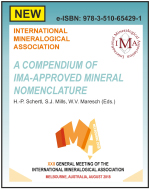Former CCM pages
COMMISSION ON CLASSIFICATION OF MINERALS (CCM)
CURRENT INFORMATION
IGC-32 in Florence (20-28th of August, 2003): All the members of CCM are kindly invited to submit their presentations to the General symposium G 15.03 titled "Crystal structures of minerals: topology and classification" (convenors: D.Pushcharovsky, E.Tillmanns). More information may be obtained at the web site: http://www.32igc.org/home.htm. The deadline for abstract submission is January 28, 2004.
New books published in 2000-2003
- Publications
ICCD Mineral Group Classification (April 2001)
Discussion paper on mineral groups (February 2001)
Mineral groups (December 2000)
Draft Proposal : Draft Discussion Paper on criteria to establish mineral groups
GENERAL INFORMATION
I. Objectives.
The aim of CCM is to collect, document and to help improve existing or proposed classifications of minerals. The CCM intends to maintain informed all the members of IMA about the new developments on the classification of minerals, and to promote meetings for their discussion.
II. The various classifications of minerals.
It is well known that the classification of minerals has changed throughout the ages the criterion of classification following the development of the mineralogical science. The criterion was first based on practical purposes, then on physical properties, later on chemical properties. Mineral classification today is largely structural, when the relation and hierarchy between minerals are based on structure similarity.
The ancient classification of minerals was mainly based on their practical uses, minerals being classified as gemstones, pigments, ores, etc., according to Theophrastos (372-287 B.C.) and to Plinius (77 A.D.). In the middle ages Geber (Jabir Ibn Hayyaan, 721 - 803) proposed a classification of minerals based on the external characters and on some physical properties such as fusibility, maleability and fracture. This physical classification was developed by Avicenna (Ibn Sina, 980-1037), Agricola (1494-1555) and A.G.Werner (1749-1817), published by his student, L. A. Emmerling (1799). This system was substantially refined by F. Mohs (1773-1839) as Natural-History System of Mineralogy (Dresden, 1820), and used in the first editions of the System of Mineralogy by J.D. Dana (since 1837). With Werner the physical classification attained its maturity, and was generally adopted at the end of the XVIII century. However, it became far too complicated. For instance, Werner mentioned 54 varieties for colour. A.F.Cronstedt (1722-1765) seems to be the first to have outlined a classification whereby the chemical properties were taken first, followed by the physical properties. R. J. Hauy (1743-1822), in Traité de Minéralogie (1801), presented a mineral classification based on the nature of metals or, as he would say now, the nature of cations.
With the development of chemistry the chemical properties became more and more important, and J.J.Berzelius (1779-1848) in 1819 proposed a chemical classification of minerals. He recognized that minerals with the same non-metal (anion or anionic group) had similar chemical properties and resembled one another far more than minerals with a common metal. He considered minerals as salts of anions and anionic complexes: F-, Cl-, Br-, I-, O2-, S2-, Se2-, Te2-, NO3-, CO32-, BO33-, SO42-, PO43-, SiO44-, BO43-, that is to say, as chlorides, sulphates, silicates, etc., and not as minerals of zinc, copper, etc. (1814, 1824). At this time Christian Samuel Weiss (1780-1856) introduced the seven crystal systems (1815) and Mitscherlich discovered isomorphy (1819) and polymorphy (1824). J.M.Dana, the founder of Dana System of Mineralogy, strongly contributed to the development of the chemical approach (1850, 1854, 3-rd and 4-th editions). With this knowledge, Gustav Rose (1798-1873) combined chemistry, isomorphy and morphology to produce a chemical-morphological mineral system: I - Elements, II - Sulfides, III - Halides, and IV - Oxygen compounds, divided into simple and complex oxides, as carbonates, phosphates, silicates, borates, sulfates. The highest standard of this classification was achieved in the System of Mineralogy by E. S. Dana (1892) and in five editions of Tabellarische Übersicht der Mineralien nach ihrer Kristallographisch-chemischen Beziehungen (1874, 1882, 1921) by P. v. Groth (1843-1927), that made this classification widely accepted.
After 1913, when the first structures of minerals were determined, the structural criterium for classification was taken into account. The first classifications of this type, which take in consideration the distribution of bonds in a structure, are that of silicates proposed by Machatschki (1928), Naray-Szabo (1930) and developed by Bragg (1930). This chemical-plus-structural classification has been applied to many other branches of mineralogy such as fluoraluminates (Pabst, 1950), aluminosilicates (Liebau, 1956), silicates and other minerals with tetrahedral complexes (Zoltai, 1960), phosphates (Liebau, 1966; Corbridge, 1971), sulfosalts (Makovicky, 1981, 1993), borates (Strunz, 1997).H. Strunz introduced a chemical-structural classification of the entire domain of minerals (Mineralogische Tabellen, 1941), followed by A.S.Povarennykh with a modified classification (1966 in Russian, 1972 in English). The chemical-structural classification of H.Strunz has gone through a number of editions, and is currently in the process of being refined in the light of recent crystal-structure determinations. In the current system, minerals are divided into 10 major compositional classes (1)elements, 2)sulfides, 3)halides, 4)oxides, 5)nitrates, carbonates, 6)borates, 7)sulfates, 8)phosphates, 9)silicates, 10)organic compounds) which are subdivided into divisions, families and groups on the basis of chemical composition and crystal structure. The paragenetic classification (Kostov, 1975) is based not only on chemical and structural pecularities of minerals, but also on the geochemical similarities of their main cations as well as on their morphology.
The structural classification of minerals was first proposed by J.Lima-de-Faria in 1983. It corresponds to the application of the general structural classification of inorganic compounds (Lima-de-Faria & Figueiredo, 1976) to minerals, which are an integral part of them. The most general approach to the structural systematics is based on the analysis of the strength distribution in crystal structures and of the directional character of the bonds. There are atoms that are more tightly bounded, and these assemblages are called structural units. They are considered as the main basis for the structural classification of minerals. Thus there are five main categories of structures: atomic or close-packed, group, chain, sheet and framework according to their dimensionality. This approach to the analysis of the crystal structures was approved by IUCr Commission on Crystallographic Nomenclature (Lima-de-Faria et al., 1990). Hawthorn in 1984 and 1985 also proposed a structural classification of minerals based on the polymerization of coordination polyhedra. Lima-de-Faria, in 1994, applied the structural classification to the most common minerals (about 500 minerals organized in 230 structure types). Detailed structural classification of silicates was elaborated by F.Liebau (1985).
References on the subject:
* Systematics of Crystal Structures and Crystallochemical Classification of Minerals: In: Advanced Mineralogy V.1 (Marfunin A.S., ed.), Springer Verlag, Berlin, 1994. p.147-167. * Lima-de-Faria J. Structural classification of mineral, an Introduction. Kluwer Acad., 1994, 346 p. "Structural Classification of Minerals" * Strunz H. Chemical-structural mineral classification. Principles and summary of system. Neues Jahrbuch fur Mineralogie, Monatshefte, 1996, H.10, 435-445.
III. News
Recent publications:
* Bokii, G.B. (1998): Systematics of natural silicates. Advances in science and technology,Series Crystal Chemistry, 31 (180 pages). * Smith D.K., Roberts A.C., Bayliss P. & Liebau F. (1998): A systematic approach to general and structure-type formulas for minerals and other inorganic phases. Amer. Mineral., 83, 126 - 132. * Lima-de-Faria J (1998): Past, present and future of the classification of minerals. Proceedings of the Intern. Symposium on the History of Mineralogy, Petrology and Geochemistry. Inst. fur Geschite der Naturwissenschaften, Munich, 17-28. * Pushcharovsky D.Yu., Lima-de-Faria J. & Rastsvetaeva R.K. (1998): Main structural subdivisions and structural formulas of sulphate minerals. Zeit. Krist., 213, 141 - 150. * Strunz H. & Nickel E.H. (1997): Tectosilicates. Chemical - structural classification. Zap. Vses. Min. Ob. V.126, N5, 1-14.




